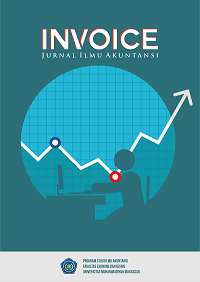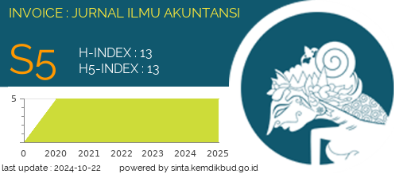Profitability, Liquidity, Solvency and Activity Analysis to Assess Financial Performance of PT. Visi Media Asia Tbk.
DOI: https://doi.org/10.26618/inv.v4i2.9001
Abstract
The purpose of this research is to find out and analyze how big the financial performance of PT. Visi Media Asia, Tbk. In measuring the company's financial performance, the data analysis technique used is financial ratio panalysis which includpes 1). Profitability (Return on assets, Return on equity and Net profit margin) 2). Liquidity (Current ratio, Cash ratio and Quick ratio) 3). Solvency (debt to assets and debt to equity ratio) and 4). Activities (Total asset turnover and inventory turnover). using the One Sample T-test with the help of the SPSS Version 20 program. The sample used in this study is the financial statements in the form of balance sheets, income and cash flows for the last 10 years from 2015. 2011 – 2020. Based on the results of research and analysis shows that 1). Financial performance of PT. Visi Media Asia Tbk during 2011-2020 in terms of profitability ratios, the results of the study show that each of these indicators is considered not performing well. 2). Liquidity, the results of the study show that through the indicators of the current ratio and cash ratio, it is known that the financial performance of PT. Visi Media Asia Tbk, is considered not to perform well. Meanwhile, when viewed from the quick ratio, it is known that the financial performance of PT. Vision of Media Asia Tbk, which is considered to be performing well. 3). Solvency, financial performance research results show that each of these indicators is considered not performing well and 4). The results of the calculation of the activity ratio show that the financial performance of PT. Visi Media Asia Tbk, from each of these indicators is also considered not to perform well.References
Pustaka berupa buku teks:
Kasmir. (2012). Analisis Lapora Keuangan. PT RajaGrafindo Persada.
Kasmir. (2018). Analisis Laporan Keuangan (8th ed.). PT RajaGrafindo Persada.
Santoso, S. (2015). Menguasai Statistik Parametrik konsep dan Aplikasi dengan SPSS (1st ed.). PT Elex Media Komputindo.
Sugiyono. (2010). Metode Penelitian Administrasi (18th ed.). ALFABETA.
Pustaka berupa jurnal ilmiah:
Abdulllah, I. (2015). Untuk Menilai Kinerja Keuangan Pada Pt . Aneka Gas Industri. 182–190.
Arsita, Y. (2021). Analisis Rasio Keuangan Untuk Mengukur Kinerja Keuangan Pt Sentul City, Tbk. Jurnal Manajemen Pendidikan Dan Ilmu Sosial, 2(1), 152–167.
Faisal, A., Samben, R., & Pattisahusiwa, S. (2018). Analisis kinerja keuangan PT. Indofood Sukses Makmur Tbk. Kinerja, 14(1), 6.
Fajrin, P. H., & Laily, N. (2016). Analisis Profitabilitas dan Likuiditas Terhadap Kinerja Keuangan PT. Indofood Sukses Makmur, Tbk. Jurnal Ilmu Dan Riset Manajemen, 5(6), 01–17.
Haryoko, U. B., Albab, M. U., & Pratama, A. (2020). Analisis Profitabilitas dan Likuiditas Untuk Menilai Kinerja Keuangan Pada Pt Pelat Timah Nusantara Tbk. Jurnal Ilmiah Feasible, 2, 80.
Marginingsih, R. (2017). Penilaian Kinerja Perusahaan Dengan Menggunakan Analisa Rasio Keuangan Pada Perusahaan Telekomunikasi Di Indonesia. Cakrawala - Jurnal Humaniora, 17(1), 21.
Muhani, M., Hapid, H., & Safril, S. (2016). Penilaian Kinerja Keuangan Dengan Analisis Rasio Keuangan Pada Perusahaan Asuransi Yang Go Public Di Bursa Efek Indonesia (Bei) Tahun 2013. Jurnal Manajemen STIE Muhammadiyah Palopo, 2(1), 32–43.
Noordiatmoko, D., Tinggi, S., & Tribuana, I. E. (2020). Analisis Rasio Profitabilitas Sebagai Alat Ukur Untuk Menilai Kinerja Keuangan Pada Pt Mayora Indah Tbk, Periode 2014-2018. Jurnal Parameter, 5(4), 38–51.
Rahman, F., Chepi, D. R., & Jumhana, S. (2020). JIMF (Jurnal Ilmiah Manajemen Analisis Laporan Keuangan Untuk Menilai Kinerja Keuangan PT. Surya Citra Media Tbk. Forkamma), 3(2), 150–160.
timan, S. (2019). Analisis Rasio Aktivitas dan Rasio Rentabilitas Sebagai Alat Ukur Penilaian Kinerja Keuangan pada PT Telekomunikasi Indonesia (Persero), Tbk. Jurnal Madani : Ilmu Pengetahuan, Teknologi, Dan Humaniora, 2(2), 270–288.
Downloads
Published
Issue
Section
License
Authors who publish with Invoice: Jurnal Ilmu Akuntansi agree to the following terms:
-
Copyright Ownership
The copyright of all articles published in this journal remains with the author(s). However, the authors grant Invoice: Jurnal Ilmu Akuntansi the right of first publication with the work simultaneously licensed under a Creative Commons Attribution 4.0 International License (CC BY 4.0). This license allows others to share, copy, redistribute, adapt, and build upon the work for any purpose, even commercially, as long as proper credit is given to the original author(s) and the source. -
Licensing and Access
Invoice: Jurnal Ilmu Akuntansi provides immediate open access to its content on the principle that making research freely available to the public supports a greater global exchange of knowledge. All published materials are available freely without subscription or payment and can be accessed, downloaded, and reused by any user provided that appropriate attribution is given. -
Permission for Reuse
For uses not covered by the CC BY 4.0 license, such as commercial reprints, translations, or any form of adaptation without clear attribution, users must obtain written permission from the editorial team. Requests for such permissions can be directed to the editorial office at: [invoice@unismuh.ac.id]. -
Plagiarism and Originality
Authors are responsible for the originality of their submissions. All articles are screened for plagiarism using appropriate tools before acceptance. Manuscripts found to contain unoriginal content or infringing materials will be rejected or retracted as per journal policy.














